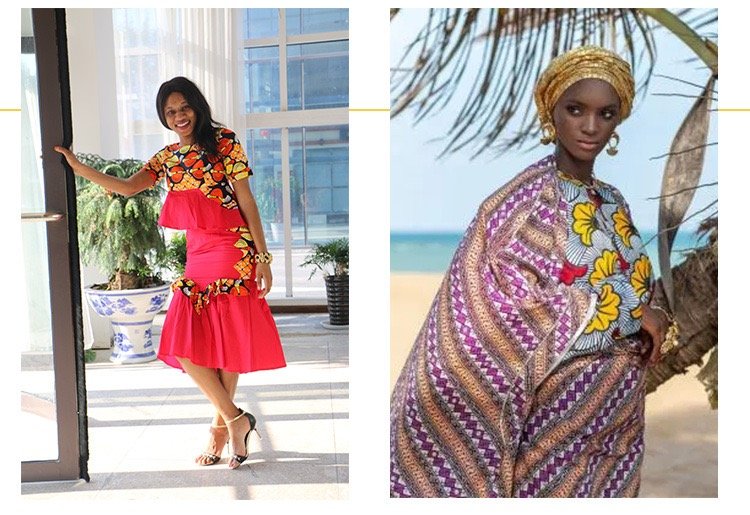African wax prints, also known as Ankara and Dutch wax prints, are omnipresent and common materials for clothing in Africa, especially West Africa. They are industrially produced colorful cotton cloths with batik-inspired printing. One feature of these materials is the lack of difference in the color intensity of the front and back sides. The wax fabric can be sorted into categories of quality due to the processes of manufacturing.
Normally, the fabrics are sold in lengths of 12 yards (11 m) as “full piece” or 6 yards (5.5 m) as “half piece”. The colors comply with local preferences of the customers. Typically, clothing for celebrations is made from this fabric.
Wax prints are a type of nonverbal communication among African women, and thereby carry their messages out into the world. Some wax prints are named after personalities, cities, buildings, sayings, or occasions. The producer, name of the product, and registration number of the design is printed on the selvage, thus protecting the design and attesting to the quality of the fabric. Wax fabrics constitute capital goods for African women. They are therefore often retained based on their perceived market value.
Wax Print Cloth Production
Prévinaire’s method for the production of imitation batik cloth proceeds as follows. A block-printing machine applies resin to both sides of the fabric. It is then submerged into the dye, in order to allow the dye to repel the resin covered parts of the fabric. This process is repeated, to build up a coloured design on the fabric. Multiple wooden stamp blocks would be needed for each colour within the design. The cloth is then boiled to remove the resin which is usually reused.
Sometimes the resin on the cloth can be crinkled in order to form cracks or lines that are known as “crackles”. The English- and Dutch-produced fabrics tended to have more cracking in the resin than those produced in Switzerland.[9] Due to the lengthy stages of its production, wax prints are more expensive to make than other commercial printed fabrics but their finished designs are clear on both sides and have distinct colour combinations.
African Fancy Print
The costly produced wax fabrics are increasingly imitated by alternative ways of manufacturing. The so-called “fancy fabrics” are produced in a printing procedure. Costly designs are printed digitally.
Fancy fabrics in general are cheap, industrially produced imitations of the wax prints and are based on industry print. Fancy fabrics are also called imiwax, Java print, roller print, le fancy or le légos. These fabrics are produced for mass consumption and stand for ephemerality and caducity. Fancy Fabrics are more intense and rich in colors than wax prints and are printed on only one side.
As for wax prints, producer, product name and registration number of the design are printed on the selvage. Even the fancy fabrics vary with a certain fashion. The fabrics are limited to amount and design and are sometimes exclusively sold in own shops.
At first the fancy prints were made with engraved metal rollers but more recently they are produced using rotary screen-printing process.
The production of these imitation wax print fabrics, allow those who cannot afford the European imported wax prints to be able to purchase them. The fancy print designs often mimic or copy the designs of existing wax print designs but as they are cheaper to make, manufacturers tend to take risks and experiment with new designs.


